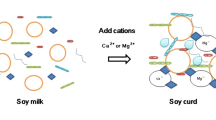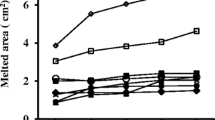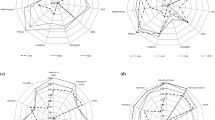Abstract
To improve the nutritional and physiological functionality of cheese analogs, fermented cheese analogs treated with Flavourzyme® were developed and the effects of roasting soy flour and fermentation time (1, 2, and 3 days) with rice straw on their quality characteristics, sodium dodecyl sulfate polyacrylamide gel electrophoresis (SDS-PAGE), isoflavone content, and antioxidant activity were examined. Heat coagulation was the highest for the unroasted and roasted soy flour groups fermented for 1 day, with the unroasted group having higher values than the roasted group, regardless of fermentation time. The daidzein and genistein contents were the highest in the soy flour and roasted soy flour groups fermented for 2 days and 1 day, respectively. The antioxidant activity and heat extension were the highest for the soy flour group and roasted soy flour group fermented for 1 day, respectively. In the SDS-PAGE patterns, protein subunits of P26 in roasted soy flour groups were consistently decomposed by increasing the fermentation time. The yield and pH in both groups decreased as fermentation time increased. The adhesiveness of the soy flour group was highly increased by fermentation, and the cohesiveness, springiness, and appearance of the roasted soy flour group were improved by fermentation. The optimum fermentation time for the fermented cheese analogs was 1 day, as higher yields, heat coagulation, heat extension, lightness, dE, cohesiveness, and springiness were obtained. Between the two groups fermented for 1 day, the soy flour group showed better heat coagulation, genistein content, antioxidant activity, cohesiveness, springiness, and adhesiveness; however, the roasted soy flour group showed better yield and heat extension.


Similar content being viewed by others
Abbreviations
- FRSC:
-
Fermented roasted soybean cheese
- FSC:
-
Fermented soybean cheese
- SDS-PAGE:
-
Sodium dodecyl sulfate polyacrylamide gel electrophoresis
References
Alvaro V, Javier V, Raul SV, Alfonso C, Justo P, Juan B, Franciso M (1999) Peptide characteristics of sunflower protein hydrolysates. J Am Oil Chem Soc 76(12):1455–1460
An SH, Lee SH, Park GS (2008) Quality characteristics of tofu prepared with various concentrations of commercial Cheonggukjang powder. Korean J Food Cook Sci 24(2):258–265
Bachmann HP (2001) Cheese analogues: a review. Int Dairy J 11:505–515
Blois MS (1958) Antioxidant determination by the use of a stable free radical. Nature 181:1199–1200
Catalano M, Ragona L, Molinari H, Tava A, Zetta L (2007) Anticarcinogenic Bowman Birk inhibitor isolated from snail medic seeds (Medicago scutellata): solution structure and analysis of self-association behavior. Biochemistry 42(10):2836–2846
Chang PK (1976) Partially delactosed whey used as NFDM replacement in American process cheese food offers economic advantages. Food Prod Dev 10(9):51–55
Cho DY, Lee MK, Kim EA, Lee SY (2015) Analysis of the isoflavone content, antioxidant activity, and SDS-PAGE of cheese analogs produced with different proteolysis and soymilk residue contents. J Korean Soc Appl Biol Chem 58(4):501–509
Choi SH, Ji YA (1989) Change in flavor of Chungkookjang during fermentation. Korean J Food Sci Technol 21(2):229–234
Chung HS, Kim CJ (2001) Contents of genistein and daidzein in tofu treated with enzyme, β-glucosidase Korea Soybean Digest 18(2):51–64
Coward L, Smith M, Kirk M, Bames S (1998) Chemical modification of isoflavones in soyfoods during cooking and processing. Am J Clin Nutr 68:1486–1491
Eymery O, Pangborn RM (1988) Influence of fat, citric acid and sodium chloride on texture and taste of a cheese analog. Science des Aliments 8:15–32
Haytowiyz DB, Beecher GR, Bhagwat S, Holden JM, Murphy PA (1999) Development of a database on the isoflavone content of foods. IFT Annual Meeting 106
Kamata Y, Chiba K, Yamauchi F, Yamada M (1992) Selection of commercial enzymes for soymilk-curd production by limited proteolysis with immobilized enzyme reactor. J Jap Soc Food Sci Tech 39:102–105
Kim OM, Gu YA, Jeong YJ (2007) Characteristics of mung bean powders after various hydrolysis protocols. Korean J Food Preserv 14:301–307
Kindstedt PS (1993) Effect of manufacturing factors, composition, and proteolysis on the functional characteristics of Mozzarella cheese. Crit Rev Food Sci Nutr 33:167–187
Ko HS, Cho DH, Hwang SY, Kim YM (1999) The effect of quality improvement by Chungkukjang’s processing methods. Korean J Food Nutr 12(1):1–6
Kramer A, Kwee WH (1977) Functional and nutritional properties of tomato protein concentrate. J Food Sci 43:207–211
Lee MK, Lee SY (2009) The quality characteristics of soy wan-jas made with different proteolytic enzyme treated textured soy proteins. J Korean Soc Appl Biol Chem 52:708–715
Lee YM, Lyu ES (2008) Physico-chemical and sensory characteristics of Cheonggukjang powder added hamburger patty. Koran J Food Cook Sci 24(6):742–747
Lee SY, Park PSW, Rhee KC (1992) Textural properties of cheese analogs containing proteolytic enzyme-modified soy protein isolates. J Am Oil Chem Soc 69(8):755–759
Lee SH, Cho YJ, Chun SS, Kim YH, Cho C (1995) Functional properties of proteolytic enzyme-modified isolated sesame meal protein. Korean J Food Sci Technol 27:708–715
Lee SY, Kim EB, Kim EJ, Lee HN, Lee MK, Oh JS, Kim SO (2008) The quality characteristics of soy cutlets using textured soy protein treated with different enzymes. Korean J Food Cult 23(4):507–513
Mahoney RR, Lazaridis HN, Rosenau JR (1982) Protein size and melt-ability in enzyme-treated, direct-acidified cheese products. J Food Sci 47:670–671
Oh HI, Eom SM (2008) Changes in microflora and enzyme activities of Cheonggukjang prepared with germinated soybeans during fermentation. Korean J Food Technol 40(1):56–62
Park EY, Ryu BH (1996) Antioxidant producing microorganism from Korean fermented food. Proceeding Kor Soc, Appl Microbiol 330
Park IK, Yang SH, Choi YS (2008) Quality characteristics of soy ice cream prepared with fermented soybean powder base and oligosaccharide and its blood glucose lowering effect. Korean J Food Sci Technol 40:88–95
Quaglia GB, Orban E (1990) Influence of enzymatic hydrolysis on structure and emulsifying properties of sardine (Sardina pilchardus) protein hydrolysates. J Food Sci 55(6):1571–1573
Santiago LA, Hiramatsu M, Mori A (1992) Japanese soybean paste miso scavenges free radicals and inhibits lipid peroxidation. J Nutr Sci Vitaminol 38:297–302
Shimada K, Fujikawa K, Yahara K, Nakamura T (1992) Antioxidative properties of xanthan on the autoxidation of soybean oil in cyclodextrin emulsion. J Agric Food Chem 40:945–948
Shon MY, Seo KI, Park SK, Cho YS, Sung NJ (2001) Some biological activities and isoflavone content of Chungkugjang prepared with black beans and Bacillus strains. J Korean Soc Food Sci Nutr 30(4):662–667
Shon MY, Kim MH, Park SK, Park JR, Sung NJ (2002) Taste components and palatability of black bean Chungkugjang added with kiwi and radish. J. Korean Soc Food Sci Nutr 31(1):39–44
Uh JH, Park M, Hsieh FH, Eun JB (2006) Physicochemical properties of roasted soybean flour in the temperature and time. Proceeding Korean J Food Preserv 196
Wang G, Kuan SS, Francis OJ, Ware GM, Carman AS (1990) A simplified HPLC method for the determination of phytoestrogens in soybean and its processed products. J Agric Food Chem 38:185–190
Webber K, Osborn M (1969) The reliability of molecular weight determinations by dodecyl sulfate-polyacrylamide gel electrophoresis. J Biol Chem 244:4406–4412
Wu ML, Chang JC, Lai YH, Cheng SL, Chiou RY (2004) Enhancement of tofu isoflavone recovery by pretreatment of soy milk with koji enzyme extract. J Agric Food Chem 52:4785–4790
Yee JJ, Shipe WF, Kinsella JE (1980) Antioxidant effects of soy protein hydrolysates on copper-catalyzed methyl linoleate oxidation. J Food Sci 45:1082–1083
Acknowledgments
This research was supported by the Chung-Ang University in 2009.
Author information
Authors and Affiliations
Corresponding author
Rights and permissions
About this article
Cite this article
Lee, SY., Cho, DY. & Lee, MK. Quality characteristics of fermented cheese analogs produced using roasted soy flour and different fermentation times with rice straw. J Korean Soc Appl Biol Chem 58, 945–954 (2015). https://doi.org/10.1007/s13765-015-0123-x
Received:
Accepted:
Published:
Issue Date:
DOI: https://doi.org/10.1007/s13765-015-0123-x




